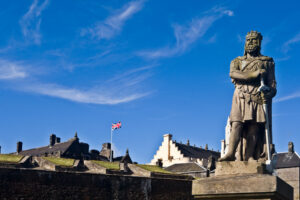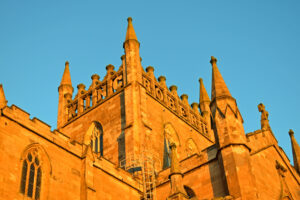Robert the Bruce (1274–1329) is remembered as one of Scotland's national heroes. A nobleman with royal blood, Bruce became the King of Scots in 1306 and led the country through one of its most turbulent chapters, the Wars of Independence. Best known for his victory at the Battle of Bannockburn in 1314, he played a vital role in securing Scotland's freedom from English rule and helped shape the country's national identity.
Robert was the eldest son born in 1274, likely at Turnberry Castle in Turnberry, Ayrshire. To Robert de Brus, 6th Lord of Annandale, and Marjorie, Countess of Carrick. His family line included ties to King David I of Scotland, giving him a strong claim to the throne.
At the time, Scotland was in a political crisis following the deaths of King Alexander III and his granddaughter, Margaret, Maid of Norway. With multiple claimants to the throne, King Edward I of England was invited to settle the dispute, ultimately choosing John Balliol as King in 1292. Disappointed by this decision, the Bruce family continued to press their claim.
By the early 1300s, tensions in Scotland had reached breaking point. In 1306, in a dramatic turning point, Bruce killed his rival John Comyn in a church in Dumfries. Just weeks later, he was crowned King of Scots at Scone.
This bold move came at a cost. The Pope excommunicated Bruce, and Edward I of England sent forces to crush his rebellion. Bruce suffered early defeats and became a fugitive, hiding in the Hebrides and possibly on Rathlin Island.
According to legend, it was during this time he watched a spider repeatedly try to spin a web. A symbol of perseverance that inspired him to keep fighting.
Returning to mainland Scotland in 1307, Bruce began a Guerrilla War against English forces and rival Scottish nobles. He slowly regained control of the country through surprise attacks, local support, and strategic brilliance. Castles were retaken, and the opposition weakened.
Edward I died in 1307, and his son Edward II lacked his father's military strength. Bruce took the chance to solidify his power, winning key victories and reclaiming much of Scotland's lost territory over the years following.
His most famous moment came in 1314 at the Battle of Bannockburn near Stirling. King Robert the Bruce led his outnumbered army to victory over the English. A pivotal moment that helped solidify his authority and Scotland's resistance.
Following Bannockburn, Bruce focused on strengthening Scotland from within. In 1320, the Scottish nobility issued the Declaration of Arbroath. A powerful letter to the Pope asserting Scotland's right to independence and Bruce's legitimacy as King. It remains one of the most important documents in Scottish history.
Diplomacy eventually paid off. In 1328, the Treaty of Edinburgh–Northampton marked England's formal recognition of Scottish independence and acknowledged Robert the Bruce as the rightful King of Scotland.
Robert the Bruce died on 7 June 1329 at his manor in Cardross, just a year after achieving formal recognition of his kingdom. Robert the Bruce’s body lies at Dunfermline Abbey, while Sir James Douglas fulfilled his final wish by taking his heart on a crusade and later returning it to Melrose Abbey.
Today, Robert the Bruce stands as a national hero and a symbol of unity, having led Scotland through one of its most defining struggles.
Statues, memorials, and landmarks across the country honour his legacy.

If you're visiting Scotland, here are some key sites linked to Robert the Bruce:
Robert the Bruce was King of Scots from 1306 to 1329 and a key figure in Scotland's Wars of Independence. Robert the Bruce is most famous for leading the Scottish army to victory over the English at the Battle of Bannockburn in 1314.
He was likely born at Turnberry Castle in Ayrshire in 1274. Although the castle is now in ruins, the nearby area remains closely associated with his legacy. You can visit the nearby Burns Cottage or Birthplace Museum in Ayr.
Robert the Bruce rests at Dunfermline Abbey. Honouring his final wish, Sir James Douglas removed his heart before burial, took it on crusade, and eventually returned it to Melrose Abbey.

The Battle of Bannockburn in 1314 was a significant Scottish victory against English forces. It secured Bruce's position as King and marked a turning point in the fight for Scotland's independence.
Yes, Trump Turnberry Golf Resort in Turnberry, Ayrshire features the King Robert the Bruce Course, named in his honour after his connections to Turnberry Castle. The course offers stunning views over the Firth of Clyde and Ailsa Craig, with the remains of Bruce's Castle beside the iconic lighthouse paying tribute to Bruce's historical connection to the area.